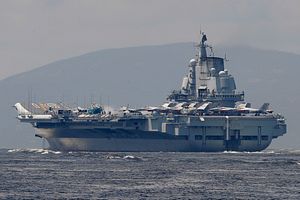The sole operational aircraft carrier of the People’s Liberation Army Navy (PLAN), the 60,000-ton Liaoning, a retrofitted Soviet-era Admiral Kuznetsov-class multirole aircraft carrier, along with its escort, entered Taiwan’s air defense identification zone (ADIZ) on March 20 at 8pm local time and sailed out of the zone around 12:30pm, Taiwan’s Ministry of Defense said in a statement.
While there have been no “unusual developments” during the carrier’s transit, the Republic of China Air Force and Navy dispatched fighter jets and ships to monitor the situation, according to the ministry. As during past transits, the ministry stressed that the Taiwanese people should not be alarmed.
The PLAN strike group is believed to be conducting routine drills. The Liaoning strike group has sailed through the Taiwan Strait twice already this year.
While Taiwan’s MoD has not offered details on the composition of the Liaoning carrier strike group, the PLAN has revealed in the past that the carrier is usually accompanied by a the Luyang III-class (Type 052D) guided-missile destroyer, a Luyang II-class (Type 052C) guided-missile destroyer, a Jiangkai II-class (Type 054A) guided-missile frigate, and alternatively one to two Yuan-class (Type 039A) or Song-class (Type 039) submarines.
The Liaoning, commissioned in 2012, primarily serves as a test platform for future Chinese naval aviation and carrier operations. As I explained in November 2016 (See: “Next Stop South China Sea? China’s 1st Aircraft Carrier ‘Ready for Combat’”):
The Liaoning can accommodate an air wing of 24 Shenyang J-15 multirole fighter jets, a variant of fourth-generation Sukhoi Su-33 twin-engines air superiority fighters, and up to ten rotary wing aircraft including Changshe Z-18, Ka-31, and Harbin Z-9 helicopters. (…) The carrier is fitted with an underpowered aircraft-launching system, a so-called ski-jump assisted Short Take-Off But Arrested Recovery (STOBAR) launch system, for fighter jets aboard the carrier.
As a result of the STOBAR launch system, aircraft operating from the Liaoning have a more limited operational range and carry a lighter payload than planes launched from U.S. Navy carriers operating steam catapults, so-called Catapult-Assisted Take-Off But Arrested Recovery (CATOBAR) systems.
China’s first domestically designed and built aircraft carrier, the Type 001A Shandong, currently under construction and set to begin sea trials in the coming weeks, will also operate a STOBAR launch system. The 65,ooo-ton carrier is a slightly improved variant of the Liaoning and is expected to be inducted into service by the end of 2018.
Construction of a third carrier, designated Type 002, reportedly began in late 2017 at a shipyard in Shanghai. According to sources, the new carrier will be fitted with a new integrated propulsion system to power high-energy consuming laser weapon systems, electromagnetic guns, and also a CATOBAR aircraft launch system.
A tentative launch date for the new warship is set for 2023. It is expected to enter service with the PLAN by 2023 at the earliest.

































